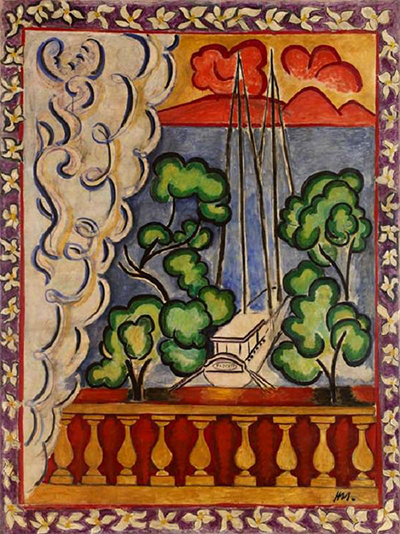 Buy Art Prints Now
Buy Art Prints Nowfrom Amazon
* As an Amazon Associate, and partner with Google Adsense and Ezoic, I earn from qualifying purchases.
A visit by Matisse to Tahiti in 1930 inspired this work of Window in Tahiti. The drawing represented a result of his meditation through the metaphor of an open window. He spent five years transferring his experience into a drawing. By use of his characteristic vivid expression, and non-natural colors, Henri Matisse completed his drawing of Window in Tahiti in 1935.
The Window in Tahiti represents a view of Tahiti's city from his hotel window. He uses the theme of an open window to accentuate the background which brings out an inviting urge to step into the unknown. Looking out into the world through the open window, one is met with a peaceful scenery. The scenery is defined by the somber colors used. Depicted herein are foliage, moored ship and the clouds. The balustrade with a decorated border of the window, and curtain, seemed to echo the island, and vice versa. The verticals of the mast correspond to the borderlines.
The window curtain, the clouds, and the tree tops all share a uniformity of a curving pattern. The border motifs decorating the frame, almost shadows the open window theme whereas the balustrade brings out the architecture. What Matisse carried on from previous works are; the open window, decorative border motifs, and the moored ship. The Window in Tahiti marked the start of his deviation from the use of somber and bold colors. He established a museum in his home town of Le Cateaur Cambresis in 1952. The museum owns hundreds of his works.
Matisse, led the fauvists, whose art employed the use of bold colors. The style, referred to as fauvism, characterized an art pursued by the movement he led. He inspired many artists and art collectors like Albert C. Barnes and Sarah Stein, who in turn popularized his works through their collections. His works were inspired by Paul Cézanne, Rodin, Gauguin and Van Gogh. In fact Paul Cézanne influenced the way Matisse structured his works. His paintings were earlier influenced by Jean-Baptiste-Siméon Chardin, Nicolas Poussin and Antoine Watteau.
In later life, he was inspired by Edouard Manet and Japanese Art. He was taught by John Russell. Matisse was friend and at the same time a rival to Picasso. Henri Matisse, used lines and colors in his art. This was seen as a revolution against the trend of western art that uses scale and proportion. He influenced the use of colors and inspired future works of the 20th century.




